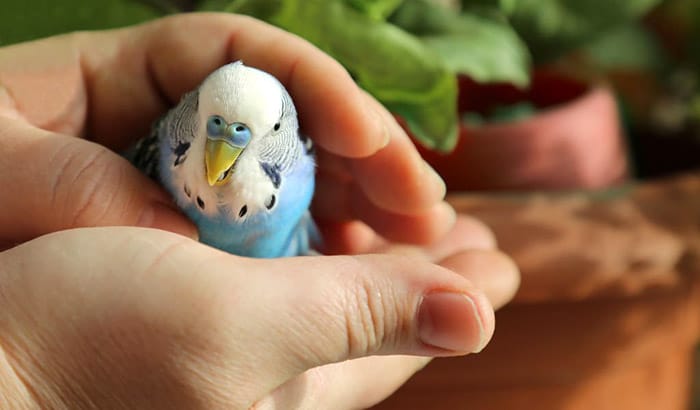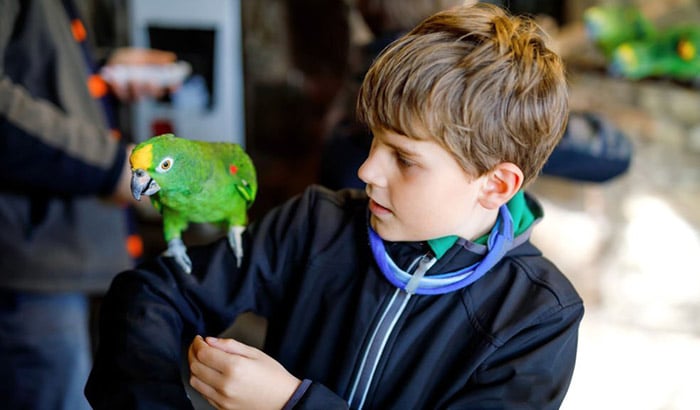If there is a pet that you want to have in your home, it should be the parakeet. It is because this bird can be taught to do so many things, such as sit on the shoulders, mimic human speech and many more. However, this bird takes time to trust, making it more challenging for anyone.
So, how to get your parakeet to trust you? This article will list different ways to make the parakeet more comfortable and trust someone. It can be challenging and requires a lot of patience, but it can be a lot of fun too.
Contents
Clipping your Parakeet’s Wing
The first order of business when the parakeet steps into your house is to select between clipping your parakeet’s wing or leaving it as it is. This step is optional, and it will all depend on you to proceed in doing it. You can even consider asking for advice from a veterinarian before deciding on your next move.
But, trimming your bird’s wings will not hurt the bird, especially if an expert does it. When the wings are trimmed, the parakeet will not be able to fly for a few months until the feathers grow.
In this situation, you can let the parakeet roam in your house and possibly leave your cage open without worrying about the bird flying away. This step will also allow the bird to explore the new environment without the worry of the bird to escape. This step will also make the bird easier to train and gain trust quickly.
On the other side of the coin, not all pet owners like to clip the bird’s feathers. Some people think that the inability to fly can mentally impact the birds. It can be stressful for them if they cannot fly. Again, the choice is yours as a pet owner.
Get the Parakeet More Comfortable in the New Environment
If you want to know how to make your parakeet trust you, it needs to be comfortable in the new place. For a bird to be comfortable in a new environment, you need to ensure that it comes with an appropriate cage. The minimum requirement of a parakeet cage is 18 inches wide, 18 inches deep, and at least 20 inches long.
This measurement is excellent to start, which will give the bird enough freedom to roam around. If you have more parakeets, then the requirements will also be different. For example, having 6 parakeets will need a cage that should be 40 inches wide, 16 inches deep, and 32-inch height.
The bird should also have easy access to water and food. Parakeets love to eat a mixture of seeds, legumes, fruits, vegetables, and nuts. These foods will give the vitamins, minerals, and the much-needed energy to be used the whole day.
Avoid Taming Your Bird Immediately
If the parakeets just come into your house, getting the bird acquainted with the new surroundings may take a week or so. But once the bird gets comfortable, you can now start taming and possibly train your new feathered friend.
Also important is the location of the cage in your house. If possible, put the cage in a room where you spend a lot of time inside. Meaning, the bird needs to get used to your presence to let them realize that you are not a predator.
You can also start talking to your bird slowly. This step will allow you to copy the bird’s flocks’ natural singing behavior to communicate that everything is safe and fine. At first, they may not understand you, but they will have an idea of the intonation of your voice.
Start by talking to the birds softly when you give them water and food. This action will create a positive association with the birds. You can also start leaving treats inside the cage while talking to the birds to make your pet more comfortable with you.
Play Music Around Your Bird
To get the parakeet to get used to the volume level of your home, you need to play music around them. They may enjoy hearing the music you play. Most parakeets like R and B, classical, and pop music.
These music genres come with a steady but predictable beat. In addition, these types of music come with a diverse range of sounds that the birds like. Parakeets like to hear upbeat songs but usually respond to gentle vocals and calming instrumentals.
Start Training the Bird to Perch or Hop
Once the bird is more comfortable with you, you can train them to preach or hop in on anything. You can start by using your hand while opening the birdcage. You can carefully put your hand in while talking softly to the bird.
You can lure them into doing it by giving them treats such as bird seeds and other food that they like. You can put the treats in your hand to entice them to hop in your hand. This training will require patience on your part but can be worth it once the birds learn how to do it.
Do not grab the birds at this stage because they will be afraid of you. Let the birds naturally come to your hand by inserting your hand while leaving there until the parakeet calms down. This type of training should last about 10 minutes until the bird can do it naturally.
Train the Parakeet to Hop on Stick
Once the birds gain your trust to eat with your hand, you can now start getting them to hop on the stick or a perch. Start by opening the cage and inserting the perch inside. You can slowly press the perch against your bird.
It can be difficult at first and will take time for the bird to learn how to hop on the perch. You can let the parakeet stay on the perch inside the cage. Do not try to move out the perch just yet. The parakeet will need more time to develop trust in you. Just be patient until the bird learns and be confident about doing it.
Train the Parakeet to Hop on Stick
Once the birds gain your trust to eat with your hand, you can now start getting them to hop on the stick or a perch. Start by opening the cage and inserting the perch inside. You can slowly press the perch against your bird.
It can be difficult at first and will take time for the bird to learn how to hop on the perch. You can let the parakeet stay on the perch inside the cage. Do not try to move out the perch just yet. The parakeet will need more time to develop trust in you. Just be patient until the bird learns and be confident about doing it.
Training the Parakeet to Hop your Finger
If the parakeet knows how to hop on a stick or perch, you can now proceed to train the bird to hop on your finger. Start by placing your finger next to the bird to see if it will hop into your finger.
You can also place your finger beside the perch once the birds hop on it to see if the bird will be interested in hopping on your finger. Once it does, you can move the bird slowly outside the cage. You do not want the bird to be afraid and let the bird get used to doing it naturally.
Do not try to move the parakeet around too much when going out of the cage. Again, when you try to train the birds, keep it short as much as possible. Once the bird is comfortable, let your friend get comfortable. Have the bird stay at least an hour per day outside the cage for playing and exercise.
How Long Does it Take to Get Your Parakeet to Trust You?
Getting your parakeet trust will take some time and require patience on your end. It will take weeks to get the trust you need for the birds formally. But the most important thing is to be patient in providing the birds’ training.
Hand-training your bird will make you know more about your bird and eventually get the trust you are looking for. You can spend 10 to 15 minutes a day training the bird and make your presence felt in the bird’s view. This step will start the trust to develop until the bird begins responding to you.
Conclusion
Learning how to get your parakeet to trust you is essential, especially in the early days of the pet in your home. It can be very challenging to tame and gain the trust of the parakeet, but it can be fun once you have already done it. You can teach so many things to the birds for you to enjoy.


